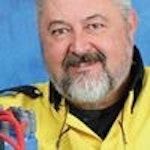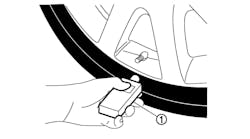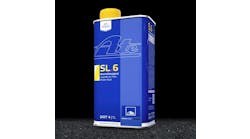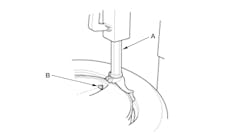New equipment acquisition represents both a substantial investment as well as an enjoyable experience. After all, who doesn’t love the look, feel and smell of new equipment? Plus, staying current in terms of features and operating condition makes the shop more efficient and more profitable.
Shop equipment represents the lifeblood of any automotive repair facility. Due to factors including age, wear and tear, and taking advantage of new equipment capabilities to increase productivity, you need to routinely consider when it’s time to pony-up and upgrade. In this article, we’ll briefly discuss a number of key upgrades for your shop’s arsenal.
Tire changers and balancers
Busy shops don’t always have the luxury of time to clean and maintain their tire changing machines as much as they would like to. Shoe sliders wear out, grit and moisture accumulate on wear surfaces, and pressure bladders and hydraulic seals eventually wear out.
In addition to the obvious wear and tear issues, consider the trend toward larger-diameter alloy wheels and shorter and stiffer tire sidewalls. If your changer isn’t designed to handle these larger sizes and increased requirements for greater rigidity during demounting and mounting, the potential for wheel and/or tire damage increases.When it’s time to upgrade, consider the selection of “no-touch” demount/mount designs that both make the job easier and greatly reduce the chance of damage.
Granted, the extent of demand for larger-diameter tires and alloy wheels may differ depending on your specific market, but the trend continues to grow. It’s time to review your existing changers and balancers to determine if they’re up to the task, in order to avoid losing this business to other shops in your area.
Also consider adding a road force balancer, which allows you to determine stiff spots that can create road force variations in mounted tires. Eliminate noise, vibration and harshness (NVH) issues, and you will go a long way toward achieving customer satisfaction.
Larger light trucks like the Ford F-350 or Ram 2500 have 10- or 12-ply 19.5-inch tires, and the stiff sidewalls are really a bear to change. You need to have a tire changer with the proper power and the helper arms to do this job.
Not all tire changers can be upgraded, so consult your tire changer manufacturer to see if there are special upgrade adapters available for your machine.Chrome-clad wheels are really gaining popularity with OEMs because they aren’t as susceptible to environmental damage, so they stay looking good longer. But if your tire changer doesn’t have the proper adapter, a chrome-clad wheel can be easily cracked and ruined. Visit www.moderntiredealer.com to search for MTD’s story on how to handle clad wheels, “Clad wheels: Handle with extreme care.”
Lifts
Ignoring routine maintenance, inspection and adjustment can lead to uneven lift rates (on twin-post lifts), hydraulic leaks, and potential operational issues that result in down-time. Monthly maintenance is highly recommended, including checking the following:
- arm adjusting locks,
- cable connections and tension,
- column lubrication,
- floor anchor bolts/studs/nut for tightness, and
- arm pivot pins.
And don’t forget to have both the operation of the overhead cut-off switch and the plumb and squareness of the columns checked regularly.Cables need to be replaced due to corrosion, kinking, crushing, heat damage and wire strand failures. Also replace the cables if there is evidence of stretch wear — if the diameter of the wire bundle is found to have diminished by 10% or more of the original diameter.
In reality, many of these checks are not performed on a monthly basis. Ignoring these inspections and maintenance risks lift reliability and safety, as well as leads to the need for lift replacement. That’s why it’s important to have your lift service company visit and perform these checks, at the very least on an annual basis.Opportunities for lift replacement go beyond the wear and tear issue. As lift makers make innovations to lift design, many lift designs offer greater flexibility in terms of the type of repairs and vehicle accommodation. For instance, the addition of a low-rise lift can offer a solid platform for wheel and brake work without tying up your other lifts. Since a low-rise lift doesn’t need to be anchored to the floor, it can be moved within the shop for greater flexibility as shop layout requirements change.
If your shop is already equipped with a twin-post lift, for example, and your market base is shifting to increased demand for heavy-duty work, you’ll need to invest in a lift that is designed for heavier and larger vehicle applications.
Many add-on accessories for various twin-post lifts also make them more flexible. They include drive-on ramps that attach to arms, add-on platforms suitable for small tractors, and more.“Consider the weight ratings of the swing arms,” says Steve Perlstein, sales manager at Mohawk Resources Ltd. “The maximum swing arm capacity of a 12,000-lb. lift might be 3,000 lbs. per arm. Let’s say you’re servicing a loaded Ford F-450. When loaded with tools, the truck may weigh 11,500 lbs.“While you might assume that the total capacity of the lift might not be overloaded, you may have 8,000 lbs. at the rear, which means that the rear swing arms, which are rated at 3,000 lbs. each, now are trying to lift 4,000 lbs. per arm. In this example, you’d need to upgrade to a 16,000-lb. lift.” If you plan to service these heavy loads, it’s critical to add a lift that will safely handle these extreme-weight-distribution applications.
Several manufacturers are now offering three-stage arms, which provide more latitude when handling longer wheelbase vehicles. In addition, a greater array of lift pads is available to accommodate specific vehicles such as some Mercedes-Benz models.
As technicians age, their backs and knees take a beating when continually adjusting twin-post lift arms. An add-on solution is a speed-lane kit which allows you to drive the vehicle onto the lift rather than lay on the ground to adjust arms.Many twin post lifts feature 2 hp motors. An increasing number of lifts are now equipped with 4 hp motors, which provide a decrease in lift times, saving time and increasing shop efficiency.
The following tips to the following questions were provided by Jason Matthews, director of U.S. field sales for the Rotary Lift division of Vehicle Service Group LLC.
1. When does it make sense to invest in a new lift when you want to expand into express service?
Tip: “Maximizing profits in express services like oil changes and tire rotation is all about speed — servicing as many customers as possible per day. We recommend investing in our Shockwave technology, available for in-ground, two-post or four-post lifts. This technology doubles the rise and descent times of these lifts, saving valuable time and allowing shops to service more vehicles.”
- Expand into a wider variety of vehicles like medium-duty trucks? Tip: “There are many shops with older 7,000 – to 9,000-lb. capacity two-post lifts where the owners find they are turning away a growing volume of business because their lifts don’t have the capacity to handle heavier vehicles. Investing in a 12,000-lb. capacity two-post or 14,000-lb. capacity four-post lift can make a shop more versatile, since they can accommodate everything from small cars to medium-duty trucks. This is an upgrade that, for most shops, won’t break the bank and affords a nice payback through expanded business.”
- Keep up with the evolution of OEM changes for new vehicles? Tip: “Cars are becoming lower and wider, trucks are getting bigger, and it’s not always possible to reach the OEM recommended pick-up points with older lifts. (Due to the use of three-stage lift arms) for two-post and in-ground lifts, this makes it possible to reach these pick-up points more easily, and allows technicians to choose from a wide range of adapters. This lets technicians precisely position the arm and chosen adapter. Retrofitting is possible, but especially with two-post lifts, it often makes more sense financially to invest in a new lift that is designed for modern vehicles.”
- Make vehicle lifting as simple as possible for new and inexperienced techs? Tips: “Consider a pad lift. Techs can be quickly trained to use them. They simply drive over the lift pads, position blocks under the pick-up points, and raise the vehicle. They don’t have to worry about positioning arms. Another tip is to install a lift spot light laser kit so techs can spot vehicles faster and easier on in-ground, four-post, two-post and scissor lifts. The laser light directs the technician to center the vehicle the first time, every time — no guessing, no re-tries.”1. Is there a guideline on when it no longer makes sense to repair a lift due to age, high maintenance costs, or inspection failure?
Tip: “It’s not uncommon to see a high-quality lift last over 20 years if well maintained. But as a rule of thumb, if a shop gets a repair estimate for more than half the price of a new lift — especially if the lift is over 15 years old — it makes more sense to replace it with a new lift and to get the benefits of the latest technology and a full warranty.
2. If lift repairs are needed, are aftermarket parts really a good deal?
Tip: “It’s important to insist on OE replacement parts to ensure proper fit and function on any brand of lift. If you buy a certified lift (one with a gold label), installing aftermarket parts on that lift can invalidate the lift’s certification. Although many people think that buying imitation parts will save them time or money, they often find that these parts cost more or aren’t in stock when you need them. To ensure that you’re buying genuine OE replacement parts, purchase them only from factory-authorized distributors and installers.”3. What’s a good and inexpensive way to improve lift safety?
Tip: “Before a technician walks under a lift, the lift should be lowered to its mechanical load-holding devices, aka locks. But this doesn’t always happen. Rotary Lift has introduced an easy way to protect technicians. LockLight is a patent-pending accessory that illuminates a bright green light when the lift is securely on its mechanical locks.”On-car brake lathes
When your techs need to resurface a brake rotor disc, or when you need to chase down and eliminate annoying brake pulsation issues, an on-car lathe is ideal. Rather than resurfacing a rotor on its own, performing the task while the rotor is secured to the hub addresses multiple potential runout variables of the rotor and hub as a package, since lateral runout issues may be stacked relative to the rotor and the hub.
Applicable to any disc brake corner, this is especially useful for front-wheel-drive applications. With the wheel removed, the rotor must be secured to the hub with all wheel fasteners torqued to specification.
Leak detection
Leak detection, whether dye or smoke, is essential for any shop to quickly and accurately locate vacuum, fluid and exhaust leaks. A variety of leak detection devices makes the shop more profitable. They can prove to be real time savers, especially when trying to find those annoying “mystery” leaks.
If you already have a smoke machine, consider adding a dye system. If you have a dye kit, consider adding a smoke machine.
Floor jacks
Hydraulic floor jacks take a terrible beating, not only from up and down use over time, but also because they are subjected to lots of dirt, rust and road salt that fall off of vehicles during jack use.
In addition, jacks can get wet during shop floor wash-downs. Seals may start to degrade and plungers may start to stick. As soon as a hydraulic floor jack begins to show signs of weakness, slow movement or leakdown, don’t delay. Send it out to a reputable hydraulic repair shop for an overhaul. Depending on the age and condition, it may better in terms of cost and downtime to simply replace it with a new jack.Even if your existing floor jacks are in good condition, consider currently available features that will improve ease of use and efficiency. Many of today’s floor jacks offer features previously not common, such as longer reach, lower profile for accommodating vehicles with minimal ground clearance, dual hand and foot control, padded lift contacts and wheel designs that resist hang-ups on rough or dirty shop floors.
A/C equipment
Condensed from Jacques Gordon’s article that appeared in MTD’s April 2017 issue: In 2014, Fiat Chrysler Automobiles N.V. began filling the air conditioning systems on almost all of its models with R1234yf refrigerant. That same year, General Motors Corp. began using it in the Cadillac XTS. Since then, GM has been gradually switching over its entire line of vehicles to R1234yf, and Ford Motor Co. has also begun using it.
Since the new machines will not recover contaminated refrigerant, your shop will need some kind of recovery-only machine. Because R1234yf is mildly flammable, shops should not just use an old R134a machine with fitting adapters; it must be specifically designed to SAE Standard J2851, which applies to recovery-only machines. Some machines will simply be described as “spark free” and that’s OK, but the holding cylinder must also be rated for flammable gases.
It’s still early, but because the refrigerant is so expensive and the equipment needed to service the system is so specialized, improper service techniques will make refrigerant contamination a much bigger issue that it has been in the past. So as your shop prepares to service cars with R1234yf, make sure the equipment list includes at least one refrigerant identifier and a recovery-only machine.Air compressors
A reciprocating air compressor’s motor should undergo an oil change about every three months or so. A rotary screw compressor’s oil should be changed about every 7,000 hours. An air intake filter should be cleaned about once each week, and replaced as needed, perhaps every three months or so. Naturally this will depend on the shop environment in terms of how much airborne debris is generated.
Water accumulation in the tank is a major concern. Not only will this lead to rust buildup and potential tank failure, but also water in the lines, which ruins pneumatic tools. A water separator and air dryer is essential. If you’ve been somewhat lax in terms of maintenance to prevent water buildup, and if that compressor has been in service for more than five years or so, internal rust may be serious enough to pose an air leak issue.
If your shop currently uses a piston motor, and you’d like to reduce the shop’s noise level, consider upgrading to a rotary screw compressor. A screw compressor offers substantially lower dba and longer/more continuous duty cycle duration for increased efficiency, especially during multi-pneumatic tool air consumption demands.Diagnostic equipment
The need to continuously stay updated in terms of diagnostic procedures is critical if the shop intends to remain competitive. Both OE systems and procedures continue to evolve at a rapid pace, requiring the latest in tool capability and software updating.
“Without new equipment, shops cannot take advantage of services,” says Scott Gompper, national retail sales manager for Launch Tech USA. Innovations such as being able to live-remote to another similar tool is but one example of diagnostic tool evolution, allowing a tech to communicate with a tech in another shop for advice, in addition to parts lookup and ordering capabilities.
“No matter what tool we discuss, after the end user understands their tool, software should be updated monthly for current vehicle coverage,” says Daniel Bemiss, marketing manager for AUTEL (Automotive Intelligence/ Intelligent Technology Corp. Ltd.).
“The end user needs to understand that all electronics have a lifespan. How many years is a diagnostic tool a viable money maker for your shop?”
The bottom line: Scan/diagnostic tools are continually evolving and becoming increasingly sophisticated and easier to use. Updating hardware and/or software is a must to stay competitive.
Other innovations in diagnostic tools, such as those offered by Drew Technologies Inc., allow remote access to a shop customer’s vehicle for full scan and diagnostics, informing the shop tech of faults and suggested repairs. These tools continue to evolve with ever-expanding capabilities. ?





